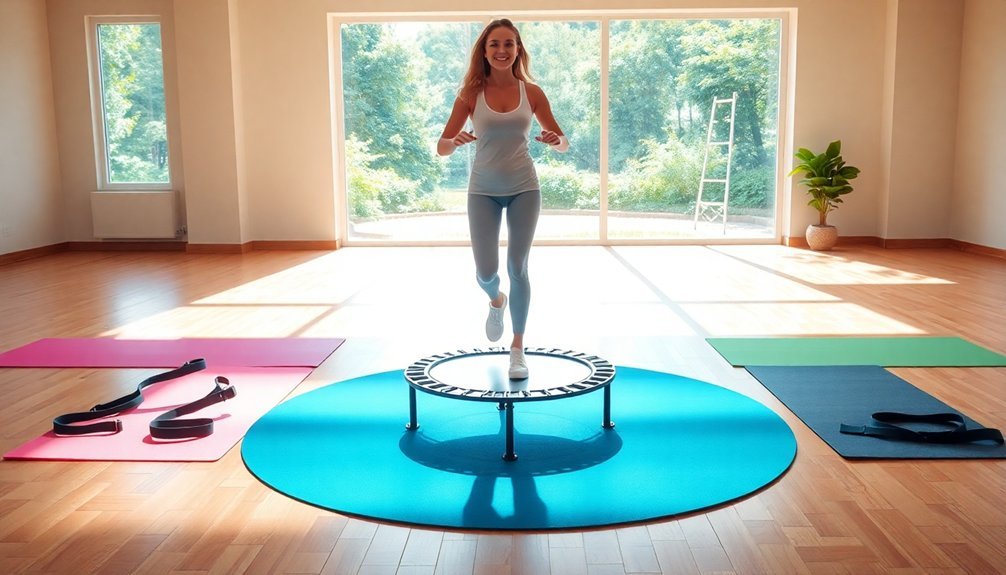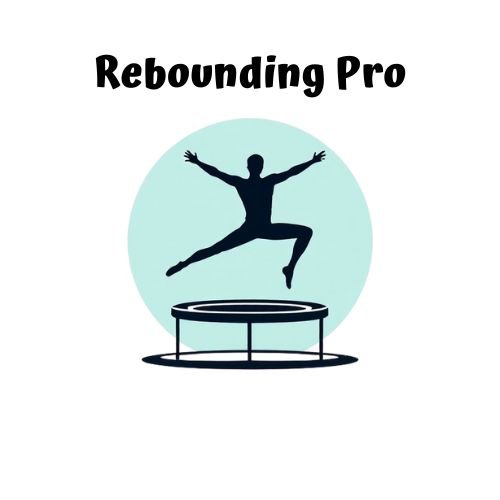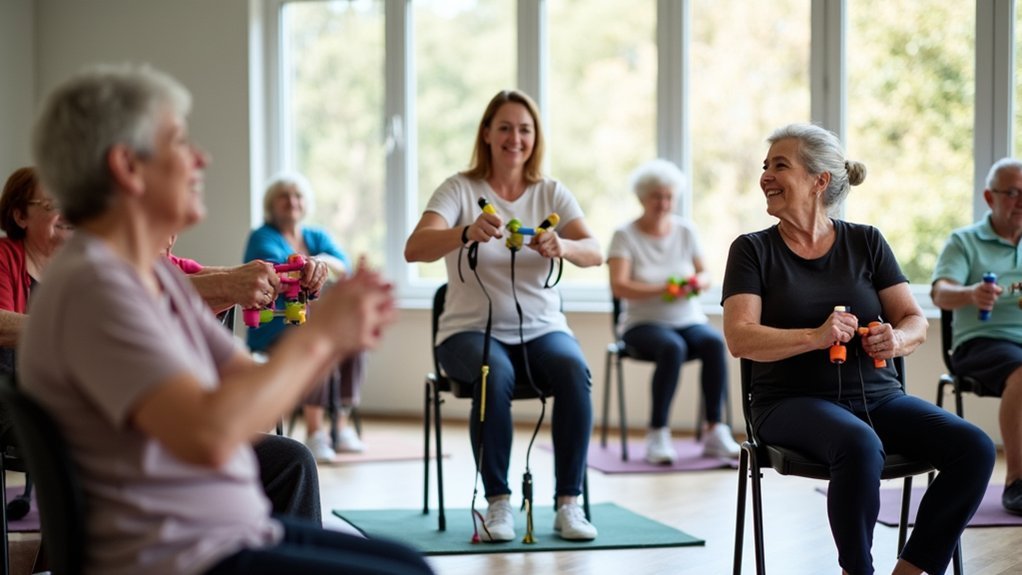Rebounding offers a gentle, effective path to recovery fitness through low-impact bouncing on mini-trampolines. You'll experience just one-sixth the joint stress of pavement exercises while still gaining cardiovascular benefits and stimulating your lymphatic system. Start with 5-10 minute sessions on a bungee-based rebounder, gradually increasing duration as strength improves. Proper posture and stability bars provide additional protection for injured areas. Discover how this accessible exercise transforms recovery into a sustainable fitness journey.
Why Rebounding Is Ideal for Injury Recovery

When recovering from an injury, finding the right exercise balance can be challenging. Rebounding offers a perfect solution with its low-impact nature that considerably reduces stress on your joints compared to running or high-impact activities.
Rebounding provides the ideal low-impact workout for injury recovery when traditional exercises might delay your healing process.
You'll appreciate how this trampoline-based exercise allows for safe movement without placing excessive strain on tender knees or hips. As you bounce, your muscles engage gently around injured areas, gradually strengthening joints without overwhelming them. The force your body experiences while rebounding is approximately one-sixth the impact compared to exercising on pavement.
What makes rebounding particularly valuable for rehabilitation is its adaptability. You can easily modify your routine based on your recovery stage and comfort level.
This versatility supports a progressive return to fitness while simultaneously stimulating your lymphatic system, which helps flush toxins and supports your immune function during the healing process.
The Science Behind Low-Impact Cardio Benefits
The science behind rebounding's effectiveness lies in its unique combination of gravitational forces and muscle engagement. When you bounce, you're creating beneficial stress on your cardiovascular system without the joint impact associated with running or jumping on hard surfaces.
This gentle bouncing motion particularly excels at stimulating your lymphatic system, enhancing immune function and supporting natural detoxification processes. Unlike high-impact exercises that may stress your joints, rebounding provides cardiovascular benefits while minimizing injury risk.
Research shows that consistent low-impact cardio like rebounding helps manage blood glucose levels, making it valuable for diabetes prevention. Similar to other low-impact workouts, rebounding offers comparable heart benefits to high-intensity exercises.
You'll also experience improved mood and reduced depression symptoms through the release of endorphins. For those recovering from injuries, rebounding offers a safe way to maintain fitness while supporting joint health and mobility.
Getting Started: Equipment for Recovery Rebounding

Selecting the right equipment forms the foundation of an effective recovery rebounding practice. For rehabilitation purposes, consider a bungee-based rebounder rather than springs, as these offer gentler resistance and lower impact on joints.
Look for models featuring stability bars if you're concerned about balance during recovery. These provide essential support while you rebuild strength. Your rebounder should be placed on a flat surface with enough clearance overhead and around you to move safely.
Before purchasing, check weight capacity ratings and mat durability. Quality rebounders range from $100-300 for recovery purposes, with premium rehabilitation models reaching higher price points. Similar to how red light therapy can enhance cellular energy production, rebounding stimulates circulation throughout the body during gentle bouncing sessions.
When setting up, verify all connections are secure and legs are properly adjusted to prevent wobbling during your therapeutic bouncing sessions.
Progressive Rebounding Routines for Rehabilitation
Building an effective rehabilitation program with rebounding requires careful progression from gentle movements to more dynamic exercises. Start with 5-10 minute sessions while holding support bars, gradually increasing duration as your strength improves. Incorporating specific exercises can help rebuild the kinetic chain from feet to shoulder, which is crucial for proper throwing mechanics.
| Phase | Focus | Duration |
|---|---|---|
| Beginner | Balance, stability, gentle bouncing | 5-10 minutes, 2-3x weekly |
| Intermediate | Lymphatic exercises, light intervals | 10-15 minutes, 3-4x weekly |
| Advanced | Shoulder mobility, dynamic movements | 15-20 minutes, 4-5x weekly |
Listen to your body and adjust your routine accordingly. For shoulder rehabilitation, incorporate gentle arm movements while maintaining stability. Combine rebounding with other therapies for thorough recovery. Remember, consistency trumps intensity—your goal is gradual improvement without risking re-injury or setbacks.
Joint Protection Techniques During Bouncing Sessions

Joint protection represents a cornerstone of successful rebounding therapy, particularly for those recovering from injuries or managing chronic conditions.
When using a rebounder, always select equipment with sufficient cushioning to minimize impact on sensitive joints.
Maintain proper posture throughout your sessions—keep your spine neutral and avoid locking your knees.
Proper form is non-negotiable—neutral spine and soft knees protect your joints during every bounce.
Don't push through pain; instead, modify your movements by reducing bounce height or eliminating deep bends that could stress vulnerable areas.
Install safety bars if you're concerned about balance, and position your rebounder in a well-lit area with ample space around it.
It's worth consulting a physical therapist who can demonstrate adaptive techniques specifically for your condition.
Remember to schedule adequate rest between sessions to prevent inflammation and support your body's recovery process.
Given that rebounding is low-impact, it provides an excellent alternative to high-stress exercises that might worsen arthritis symptoms.
Cardiovascular Gains Without the Pain
You'll boost your heart health with minimal stress when you practice gentle bouncing techniques that gradually increase your heart rate.
Your circulation improves dramatically as each bounce creates a pumping action that moves blood efficiently through your system without the jarring impact of running or jumping.
These heart-friendly movements allow you to achieve significant cardiovascular benefits while protecting your joints, making rebounding an ideal option for those recovering from injuries or managing chronic conditions. Even short, two-minute sessions can effectively optimize oxygen supply throughout your body while promoting lymphatic drainage.
Heart-Friendly Bounce Techniques
When approaching cardiovascular exercise, many people worry about painful impact on their joints, but rebounding offers a heart-healthy alternative that eliminates this concern. The trampoline's surface absorbs up to 87% of the impact, protecting your knees and ankles while still effectively elevating your heart rate.
Start with gentle bounces, keeping your feet close to the surface while engaging your core. As you gain confidence, incorporate arm movements to enhance upper body involvement and boost circulation. You'll notice improved stamina as your heart strengthens from this consistent aerobic activity.
For those monitoring blood pressure, rebounding provides cardiovascular benefits without dangerous spikes in pressure. The rhythmic bouncing motion naturally improves oxygen delivery throughout your body, making this an ideal exercise for cardiac conditioning during recovery. Regular rebounding sessions of at least 10-15 minutes can provide significant lymphatic drainage benefits while supporting overall cardiovascular health.
Gentle Pulse-Raising Exercise
Rebounding offers a surprisingly effective option for gentle pulse-raising exercise that won't stress your joints or leave you in pain. In just 3-10 minutes on a rebounder, you'll experience increased heart rate and improved blood flow without the impact of traditional cardio.
| Rebounding Benefit | Why It Matters |
|---|---|
| Increased oxygen delivery | Powers your muscles efficiently |
| Enhanced blood circulation | Delivers nutrients where needed |
| Gradual heart rate elevation | Prepares cardiovascular system safely |
| Improved joint lubrication | Reduces stiffness and injury risk |
| Better neuromuscular coordination | Enhances balance and control |
You'll notice your body temperature rises slightly as you bounce, preparing muscles for more intense activity. This gentle vasodilation expands blood vessels, supporting efficient energy metabolism while your body gradually adapts to increased activity levels. As an active warm up, rebounding engages large muscle groups throughout your body, making it an excellent preparation for more intense exercise.
Circulation Without Strain
The unique gravitational advantage of a rebounder makes it an ideal tool for cardiovascular health without joint strain. Unlike high-impact exercises, rebounding distributes pressure evenly across your body, protecting your joints while still strengthening your heart muscles.
You'll experience impressive efficiency with rebounding—NASA research shows just 10 minutes equals 30 minutes of running in cardiovascular benefits. Your heart function improves, blood pressure decreases, and endurance builds—all with minimal stress on your body.
As you bounce, you're stimulating lymphatic flow and increasing blood circulation, delivering oxygen and nutrients more effectively to cells. This enhanced circulation supports faster recovery and reduces inflammation. The process aids immune cell movement, significantly enhancing your body's natural defense against infections and illnesses.
You'll enjoy the cardiovascular gains of intense exercise without the accompanying pain, making rebounding perfect for fitness recovery.
Balancing Intensity and Recovery in Your Routine
Finding the sweet spot between pushing your limits and giving your body time to recover is essential for any effective fitness regimen. Rebound training offers this balance by segmenting workouts into intervals of exertion followed by recovery breathing, allowing you to maintain progress without overtraining.
Monitor your recovery using tools that track heart rate variability and sleep quality, then adjust your schedule accordingly. On recovery days, rebounding provides an ideal low-impact option that stimulates lymphatic drainage and enhances circulation without taxing your joints. Begin each session with 1-3 recovery breathing exercises to optimize oxygen delivery and support mobility.
Listen to your body and incorporate flexibility in your training schedule. Mix rebounding with traditional strength work while ensuring proper nutrition—adequate protein, hydration, and balanced macronutrients support muscle repair.
Remember that quality sleep is when most recovery occurs, so prioritize rest as much as activity.
Rebounding After Specific Injuries: Tailored Approaches
When recovering from an injury, your approach to exercise must be methodical and personalized to avoid setbacks or re-injury. Before starting, consult with a healthcare professional to evaluate your specific condition.
Injury recovery requires patience and professional guidance—personalize your exercise plan for safe, effective rehabilitation.
For knee injuries, focus on gentle range-of-motion exercises and muscle strengthening around the joint.
With ankle or foot injuries, emphasize balance work and proprioception training while wearing supportive footwear.
If you're managing shoulder injuries, modify your rebounding routine to minimize upper body strain—concentrate on core engagement and lower body movements initially, then gradually incorporate light arm movements as healing progresses.
Regardless of injury type, begin with low-impact bouncing and gradually increase intensity.
Your rebounder can provide cardiovascular benefits while supporting lymphatic circulation—all with minimal stress on healing tissues. Consider utilizing stability bars for added security during your initial recovery sessions, especially for those with balance concerns or more serious injuries.
Monitoring Progress: Signs Your Body Is Healing
When recovering with rebounding, watch for physical benchmarks like reduced joint pain, improved range of motion, and greater muscle strength—all indicating your body's healing process.
You'll also notice significant energy improvements as your lymphatic system clears toxins more efficiently and your cardiovascular health strengthens.
The gentle bouncing motion helps establish a better oxygen balance throughout your body, supporting tissue regeneration and accelerating healing.
These positive changes, coupled with better sleep quality and mental clarity, confirm you're on the right path to complete recovery.
Physical Recovery Benchmarks
Understanding your body's response to rebounding workouts requires attention to specific recovery markers that signal healing and adaptation.
Monitor your muscle soreness (DOMS), which typically peaks within 24 hours post-workout and should gradually decrease—a positive sign your tissues are healing.
Track your jump performance between sessions; improvements in counter movement jump height reliably indicate neuromuscular recovery.
Pay attention to your heart rate variability, which reflects your nervous system's balance and readiness for training.
After intense rebounding sessions, creatine kinase levels naturally rise but should return to baseline within 48 hours.
Use perceived recovery scales to assess your readiness for the next workout. Research shows that PRS scale reliably identifies readiness and correlates with performance metrics, particularly in determining upper body recovery status.
These subjective measures, combined with objective indicators like resting heart rate, provide a thorough picture of your recovery status and guide your training progression.
Energy Boost Indicators
Recognizing positive energy shifts provides crucial feedback about your body's healing response to rebounding exercises.
As you incorporate regular rebounding sessions into your routine, your cellular energy production improves, creating noticeable enhancements in your daily vigor. The lymphatic drainage stimulated by the gentle bouncing motion helps clear toxins from your system, further supporting your renewed energy.
Watch for these key indicators that your energy systems are responding:
- Sustained endurance throughout the day without the mid-afternoon slump, reflecting improved mitochondrial function and oxygen utilization.
- Enhanced mental clarity and reduced brain fog, signaling better cerebral circulation and endorphin regulation.
- Reduced recovery time between workout sessions, indicating improved cellular resilience.
- Improved digestive efficiency with less bloating and more consistent energy after meals, showing enhanced nutrient absorption and utilization.
Combining Rebounding With Other Therapeutic Practices
Although rebounding delivers impressive fitness benefits on its own, combining it with complementary therapeutic practices can greatly enhance recovery outcomes. You'll find that pairing rebounding with hydrotherapy, red light therapy, or therapeutic horseback riding creates powerful synergistic effects for both physical and mental healing. Integrating rebounding with red light therapy creates a particularly effective holistic approach to wellness that targets both cellular function and lymphatic flow.
| Therapy Combination | Primary Benefits | Best For |
|---|---|---|
| Rebounding + Hydrotherapy | Improved muscle tone and circulation | Motor disorders, hypertonia |
| Rebounding + Red Light | Enhanced cellular energy and oxygen utilization | Overall rejuvenation, weight management |
| Rebounding + Horse Riding | Sensory stimulation and coordination | Physical disabilities, confidence building |
These combinations provide multidimensional approaches to treatment that you can't achieve through single-modality therapy. The rhythmic movements in rebounding complement other therapies while boosting endorphin release, reducing anxiety, and improving your mental well-being.
Success Stories: Transformative Recovery Journeys
You'll find hope in the stories of cancer survivors who've regained strength and mobility through gentle rebounding practices.
Post-surgery patients have transformed their recovery timelines by incorporating graduated bouncing routines into their rehabilitation protocols.
These remarkable journeys showcase how rebounding offers a uniquely effective path back to wellness after major medical interventions. People of all ages benefit from rebounding, with even active octogenarians discovering improved balance and stamina through this accessible exercise form.
Cancer Survivors Bounce Back
While facing the immense challenges of cancer treatment, survivors worldwide have discovered rebounding as a transformative tool in their recovery journeys.
This gentle exercise form has helped patients with various cancer types, including lymphoma and myeloma, regain strength and energy during their healing process. Gary's experience with multiple myeloma demonstrates how crucial appropriate physical activity becomes after experiencing severe medical setbacks.
Four key benefits cancer survivors experience with rebounding:
- Lymphatic stimulation – Helps with detoxification and immune support when bodies need it most
- Stress reduction – Alleviates anxiety and depression common during recovery
- Adaptable intensity – Can be modified to accommodate different physical limitations during treatment
- Community connection – Provides opportunities to join supportive networks of others on similar journeys
You'll find rebounding integrates well with traditional treatments while offering a cost-effective way to nurture both physical and mental wellness.
Post-Surgery Fitness Triumphs
Beyond cancer recovery, rebounding has transformed the lives of countless individuals traversing the challenging path of post-surgical rehabilitation.
You'll find that structured exercise programs greatly enhance your recovery speed while reducing hospital stays. Many bariatric surgery patients have incorporated gentle rebounding into their gradual physical activity regimen, experiencing considerable weight loss and improved mobility. Stephanie's remarkable journey illustrates how patients can achieve 77 pounds of weight loss following bariatric procedures when committed to their recovery plan.
Those who commit to pre-surgery fitness routines often navigate post-operative challenges more effectively. Your body responds remarkably when you combine rebounding with proper nutrition and follow-up care.
Most impressive are the lifestyle transformations—patients reducing or eliminating medications for conditions like diabetes and hypertension.
Despite initial struggles with temporary discomforts, you'll discover that rebounding offers a low-impact option that builds strength while respecting your body's healing process.
Long-Term Maintenance: Beyond Initial Recovery
After completing your initial recovery phase, rebounding exercises offer substantial benefits for long-term health maintenance.
You'll strengthen your cardiovascular system while reducing your heart's workload and improving capillary circulation. Regular bouncing supports your lymphatic system, enhancing immune function and toxin removal.
- Bone and muscle health – Consistent rebounding increases bone density and builds muscle endurance by boosting cellular mitochondria.
- Balance preservation – You'll maintain better coordination and reduce fall risks as you age.
- Cardiovascular efficiency – Your heart will work more efficiently with improved oxygen delivery.
- Joint protection – The low-impact nature preserves joint health while still providing effective exercise. The exercise remains low-impact cardiovascular for all fitness levels, making it ideal for ongoing recovery maintenance.
This sustainable approach to fitness helps you maintain independence and quality of life long after your initial recovery period ends.
Frequently Asked Questions
Can Children Safely Use Rebounders for Fitness Development?
Yes, children can safely use rebounders for fitness development if you guarantee proper supervision, age-appropriate equipment with safety features, and follow weight capacity guidelines. They'll gain strength, balance, and coordination benefits.
How Does Rebounding Affect Common Medications and Their Absorption?
Rebounding may influence medication absorption by enhancing blood circulation and lymphatic flow. You'll experience potential changes in how quickly your body processes medications, though you should consult your doctor about specific drug interactions before starting.
Is Rebounding Safe During Pregnancy and Postpartum Recovery?
Rebounding during pregnancy requires medical clearance and caution due to G-force concerns. Once your doctor approves, it's beneficial postpartum for pelvic floor rehabilitation and core strengthening, but you shouldn't start until after your six-week checkup.
Can Rebounding Help With Lymphedema After Cancer Treatment?
Yes, rebounding can help manage lymphedema after cancer treatment by stimulating your lymphatic system. It's gentle yet effective for improving drainage, reducing swelling, and enhancing circulation when you're recovering from lymph node removal or radiation.
How Does Rebounding Compare to Water Therapy for Rehabilitation?
You'll find rebounding is more accessible with less equipment than water therapy, though both offer low-impact rehabilitation. Rebounding boosts lymphatic flow specifically, while water therapy excels for joint support through buoyancy.
In Summary
As you incorporate rebounding into your recovery journey, you'll find it's more than just exercise—it's a sustainable path back to wellness. You're rebuilding strength while protecting healing tissues. Don't rush the process; celebrate small improvements as victories. Whether you're recovering from surgery or managing chronic pain, the gentle bounce of rebounding can carry you toward lasting health and renewed confidence.





Leave a Reply